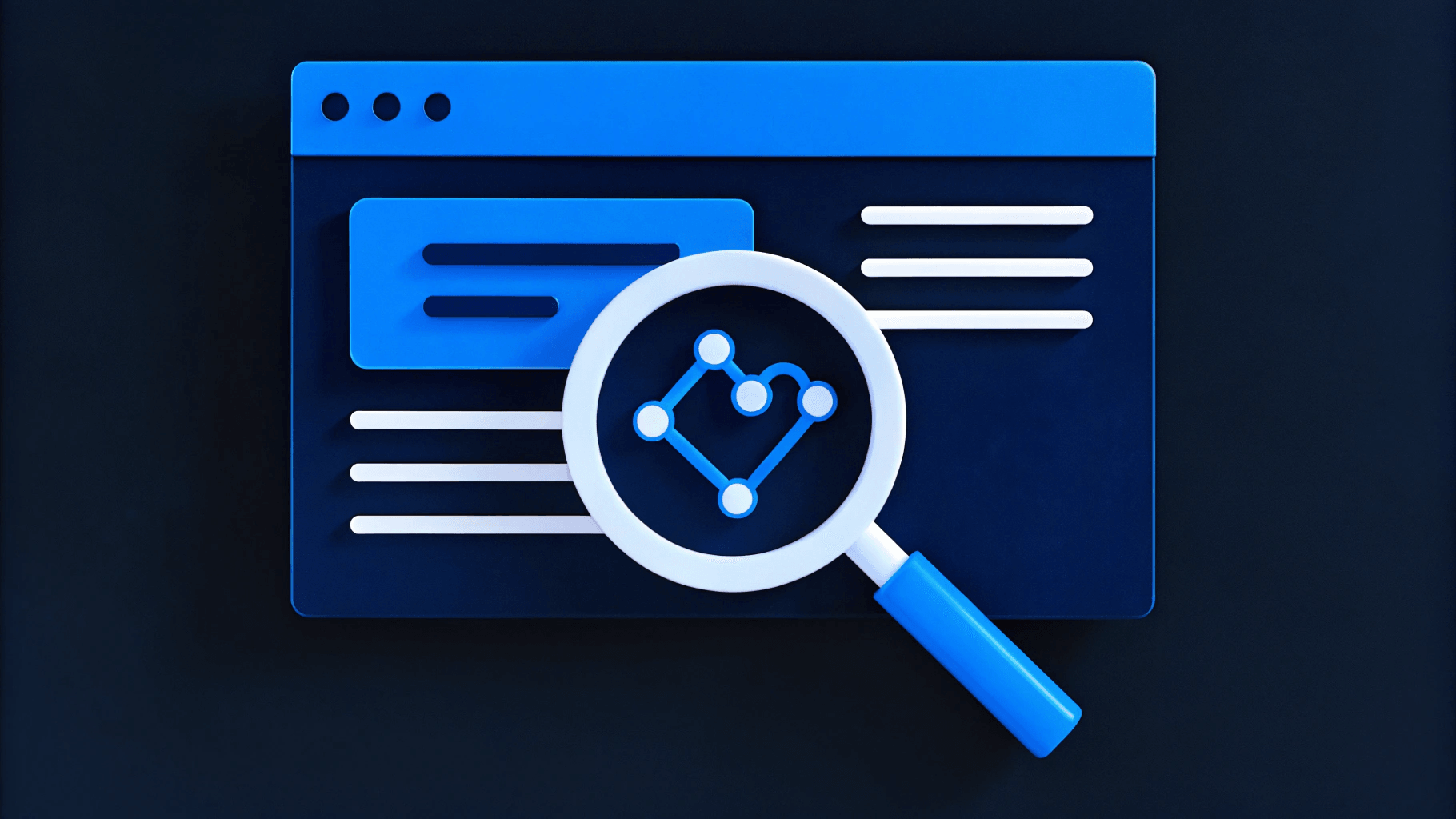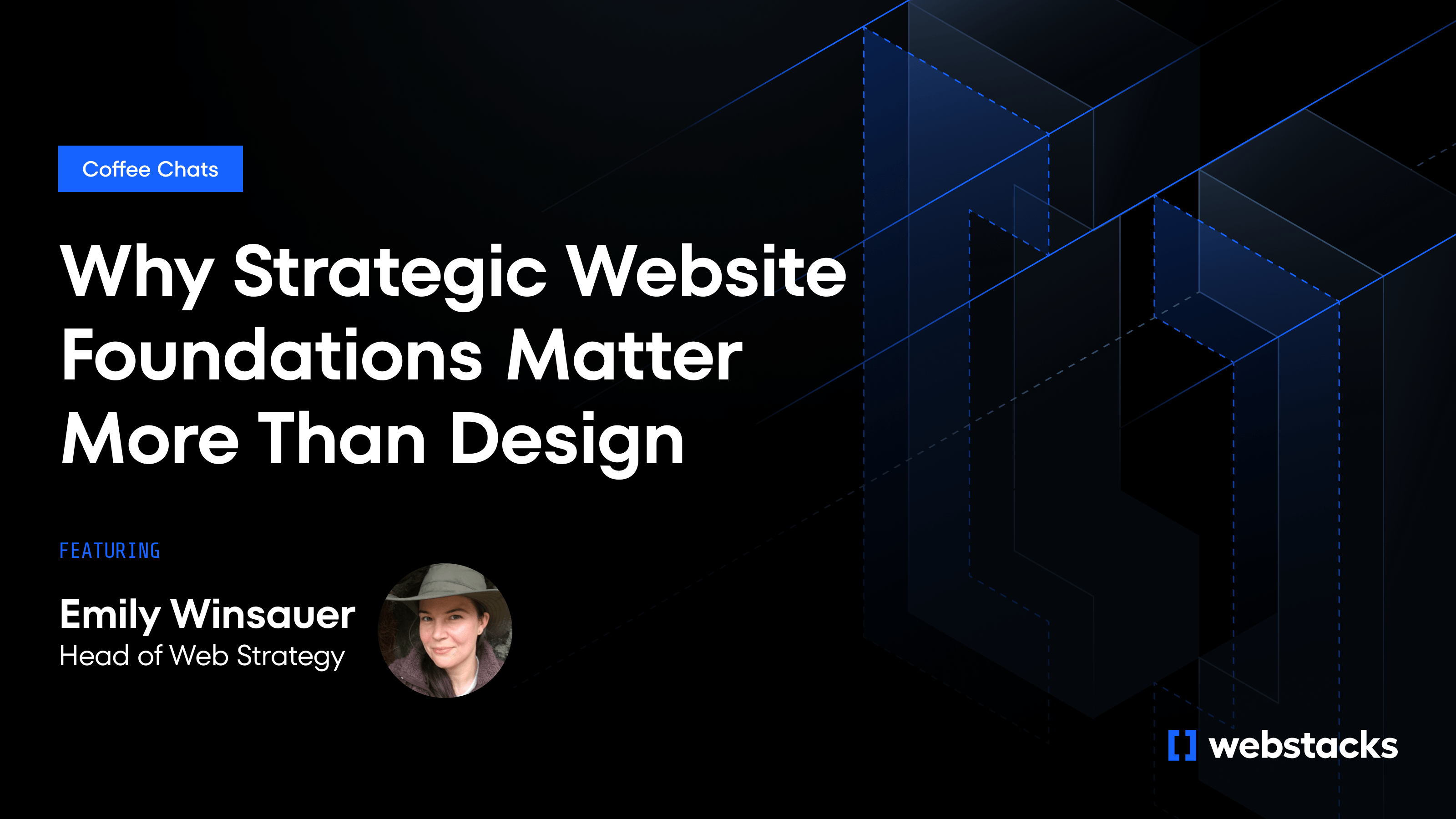This framework enables you to prove website ROI to executives by connecting site performance directly to revenue metrics they track. AI can connect website activity directly to revenue, but only when your data infrastructure and architecture support it. Most enterprise websites can't make this connection because they're built on monolithic page structures that trap insights in vanity metrics and force nine-month development cycles for strategic changes.
Component-based architecture solves this by treating every hero section, form and CTA as a measurable, swappable unit. AI identifies which components drive revenue. Marketing deploys changes in hours. Leadership sees direct lines from website activity to closed deals. This combination transforms your website from a periodic rebuild project into a growth engine that compounds velocity over time.
Why Traditional Website Planning Fails Executive Objectives
Traditional website planning operates on a nine-to-twelve-month redesign cycle that disconnects strategic decisions from execution. Executives set annual growth targets in January. Marketing plans campaigns in February. Developers start building in March. By the time the site launches in October, market conditions have shifted and the original business objectives no longer align with current priorities.
Page-centric builds compound this disconnect. Layout, copy and code are coupled inside single templates. When marketing requests changes to support a new product launch or competitive response, developers must touch every affected page. Experiments stall in development backlogs. Executive insights get limited to vanity metrics like page views and bounce rates rather than demo-to-sales-qualified-lead (SQL) conversion or expansion revenue.
Monolithic CMS platforms force you to wait for release cycles to test headlines or adjust messaging. Each update compounds technical debt and turns strategic pivots into costly refactor projects. The website becomes a constraint on business agility rather than an enabler of it.
Component-driven models assemble sites from modular, reusable blocks. Each block includes analytics hooks. Update one component and changes cascade everywhere. These systems scale efficiently because teams can modify components quickly, enabling rapid experimentation traditional builds can't match.
AI pinpoints which component drives revenue. Marketing swaps it into new contexts while leadership sees measurable impact. Before AI can deliver these insights, you need clarity on what you're optimizing for.
Translate Business Goals into Website KPIs Executives Trust
Every AI initiative begins with one question: Which metrics matter to your CFO? Anchoring conversations here turns vague growth objectives into concrete metrics the C-suite can monitor in real time.
Start by mapping each business objective to a single, measurable website signal. Your board expects annual recurring revenue to jump 15%? The website counterpart might be faster demo-to-SQL conversion. A SMART goal reads: "Increase demo-request-to-SQL rate from 12% to 18% by Q3, unlocking $4M in additional ARR."
Resist the temptation to map multiple website KPIs to one business goal. This creates measurement ambiguity that stalls AI prioritization. If you can't choose a single website KPI, the business objective itself needs clarification. Better to start with one imperfect-but-clear metric than three academically-correct-but-competing ones.
Here are five common business goals and how they translate to website signals:
- Accelerating new ARR translates to improving demo-to-SQL conversion rate. AI predicts visitor intent and personalizes CTAs to move the net-new revenue metric your board tracks.
- Protecting revenue means monitoring upgrade click-throughs on help articles. AI identifies churn-risk cohorts in real time, helping you safeguard gross dollar retention before customers leave.
- Shortening the sales cycle requires tracking time from first visit to form fill. AI reveals micro-journeys that signal purchase urgency, directly impacting pipeline velocity.
- Expanding into new segments focuses on first-time visitor engagement by persona. AI detects content gaps for emerging audiences, supporting your market share objectives.
- Lowering customer acquisition cost demands measuring paid-traffic ROI by landing page. AI optimizes spend allocation based on propensity to convert, reducing cost per acquisition.
With clear KPIs defined, the next step is validating whether your data infrastructure can actually measure them.
Audit Data Infrastructure for AI Readiness
Before models can surface revenue-grade insights, validate what data exists, where it lives and whether it's clean enough for machine learning. Skipping this audit guarantees misleading insights that erode stakeholder trust.
Start by mapping your data supply chain from visitor click to closed-won deal. At minimum, capture traffic logs, conversion funnel stages (website visits, marketing-qualified leads, sales-qualified leads), content metadata, CRM revenue tags and competitive benchmarks.
Marketing automation, web analytics and CRM platforms rarely share identical identifiers. Reconciling IDs sounds straightforward but typically uncovers deeper issues: marketing automation systems create duplicate contacts, CRM workflows strip tracking parameters, timestamps don't align across systems, and parent-child account hierarchies conflict between platforms.
Attribution models conflict across platforms. Expect this reconciliation to surface organizational process problems beyond technical integration gaps. Plan governance conversations before attempting technical fixes. The technology integration follows process alignment, not the other way around.
Component-based websites capture richer engagement metrics. When each hero section, form and CTA exists as a discrete, tagged element, tracking systems can log granular interactions that monolithic pages can't capture. Scroll depth, form interaction rates and CTA hovers help predictive systems pinpoint which assets accelerate pipeline velocity.
Strengthen your dataset with Schema.org structured data so AI crawlers recognize product features instantly. Use semantic HTML5 tags that clarify content hierarchy for language models. Review consent banners and retention schedules against GDPR and CCPA guidelines.
Use this checklist as your pass/fail rubric:
- All key events and revenue tags flow into a single warehouse in near real time
- Unique visitor IDs persist from anonymous session to post-login activity
- Component library emits granular engagement events without developer intervention
- Structured data covers every product, article and FAQ
- Privacy controls enforce opt-in, retention and deletion on demand
If fewer than three checkboxes are green, focus on data infrastructure before AI investment. If three to four are green, you can begin with read-only AI applications like predictive lead scoring while building remaining capabilities. Only when all five are green should you pursue write-capable AI that personalizes user experiences in real time.
Many organizations rush to personalization and discover their foundation can't support it. The result requires expensive rollbacks and stakeholder trust recovery.
When your data infrastructure is validated and your KPIs are clear, establish the governance that will sustain AI operations.
Establish Cross-Functional Governance Before Choosing Models
Clear KPIs reveal what to measure and validated data confirms you can measure it. But AI implementations fail when cross-functional teams operate in separate cadences with conflicting priorities. Before selecting specific AI models or vendors, establish the governance structure and operational rhythm that will sustain AI operations long-term.
Create a steering group including marketing leadership, web strategists, data analysts, IT security and an executive sponsor. This group owns the roadmap and resolves trade-offs around brand consistency, deployment speed and risk.
Expect these trade-offs to be contentious. Brand teams will resist modular constraints that enable AI optimization. Security teams will challenge data unification that powers personalization. Executive sponsors will push for faster results than infrastructure maturity allows. The steering group creates a forum where these tensions surface early and get resolved through explicit prioritization rather than passive-aggressive project delays.
Build an operational rhythm that keeps teams aligned:
- Bi-weekly backlog grooming brings together marketers, analysts and developers to align on campaign requirements and implementation priorities.
- Monthly model retraining prevents drift while incorporating fresh interaction data.
- Quarterly executive reviews connect website KPIs directly to board-level objectives.
This cadence eliminates the rework cycles that occur when teams discover misalignment weeks into implementation, enabling campaign launches in days rather than months.
Benchmark current team competencies and create enablement tracks. Marketers need prompt engineering skills. Product managers need model evaluation frameworks. Legal teams need ethical AI compliance training. When training integrates with regular ceremonies, learning scales alongside delivery. With governance established, you're positioned to select AI models that align with strategic priorities.
Select AI Models That Align with Strategic Priorities
Governance and operational rhythm create the foundation for sustainable AI operations. Now the question becomes which specific AI capabilities will move your KPIs. Different model families tackle different optimization problems, and success depends on matching the right approach to each strategic priority. Three model families address different optimization needs:
- Machine learning predicts high-intent cohorts by correlating session behavior with SQL creation. Use ML when pipeline velocity is your priority and you need to identify which visitor segments convert fastest.
- Natural language processing optimizes content to resonate with each micro-segment. Use NLP when brand perception matters most and you need to test messaging variations that maintain voice consistency across audiences.
- Reinforcement learning iterates layouts in real time, promoting variants that beat baseline conversion rates. Use RL for lifetime value expansion when you need to personalize upsell triggers and cross-sell pathways inside your component library.
Most B2B companies start with machine learning for lead scoring and visitor segmentation. They add natural language processing six to twelve months later once they have baseline performance data. They only introduce reinforcement learning after the first two are stable and delivering measurable ROI.
This sequencing matches organizational learning curves better than deploying all three simultaneously, even when technical capacity exists to do so. Running multiple model types at once makes it impossible to isolate which insights came from which system, creating attribution confusion that undermines team confidence in AI recommendations and stalls adoption.
Start with off-the-shelf tools like Google's prediction APIs or pre-trained recommendation engines to validate value quickly. Move to custom workflows when your data set becomes strategic. Specifically, move to custom when you have 18 months or more of unified web and CRM data and when AI recommendations begin surfacing insights your team wouldn't reach through manual analysis alone.
If vendor dashboards still tell you things you already know, off-the-shelf tools remain the right choice. The key is to start small, prove impact, then scale once ROI is obvious. Build on an ethical framework with transparency about data lineage, fairness in outputs and explicit alignment with KPIs:
prompt = """
Company KPI Snapshot:
- ARR: $42M
- Demo-to-SQL rate: 12%
Prioritize three website changes that could increase ARR in the next two quarters. Return:
1. Hypothesis
2. Impact forecast
3. Required component change.
"""With the right models selected and ethical guardrails in place, the next step is turning those insights into concrete website changes.
Turn AI Insights into Prioritized Component Roadmaps
AI models surface optimization opportunities, but insights mean nothing without systematic execution. Converting recommendations into revenue-bearing website changes requires disciplined prioritization and a clear implementation path.
When Calendly rebuilt its site with Webstacks, the team increased development agility through adopting a modern, scalable website approach. When your model identifies that demo requests spike when banners emphasize integrations, update that component and deploy across dozens of pages instantly.
Use a two-axis prioritization grid with projected revenue impact on the Y-axis and implementation effort on the X-axis. Building this grid collaboratively with your steering group helps keep everyone aligned and on track. High-impact, low-effort components enter the next sprint. Follow this implementation discipline:
- Feed interaction data into your model to identify high-impact opportunities
- Match AI insights to your component inventory and prioritization grid
- Deploy through controlled rollouts
- Track lift against target KPIs
- Merge wins or archive underperformers
Start small with a single personalized component to validate data flow and model accuracy before scaling. Choose your pilot component carefully. Avoid homepage heroes because they're too visible for unproven technology. Avoid footer CTAs because they're too low-traffic for meaningful signals.
Instead, pilot on high-traffic, mid-funnel pages like pricing comparisons or feature deep-dives where visitor intent is clear and conversion impact is measurable. This balances learning value with controlled risk. Sustaining this velocity requires the right vendor partnerships and integration strategy.
Integrate AI Tools Without Replacing Your Existing Stack
Component-based roadmaps identify what to build and in what order. Execution speed depends on whether your tools can support that velocity without forcing you to rebuild your entire technology ecosystem. Component-based roadmaps enable fast execution when your tools integrate cleanly. Most enterprise marketing teams face a familiar trap: promising tools that require complete stack overhauls to function properly. The selection process becomes high-stakes because bad implementations compound over time, creating technical debt that constrains future growth.
Tool evaluation centers on four non-negotiables: API openness for clean integration, data ownership for audit access, compliance alignment with privacy requirements and workflow compatibility for team adoption without developer intervention.
Map candidates against your existing infrastructure. Component-based architectures typically include a headless CMS feeding design systems, customer data platforms stitching visitor identities, experimentation engines running tests and analytics warehouses capturing behavioral data. AI tools must integrate with at least two layers.
What if your existing CMS doesn't support the component architecture AI optimization requires? You have three options. First, accept limited AI capabilities within your current platform's constraints. Second, run AI optimization in parallel through a dedicated experimentation layer, which preserves your CMS but adds complexity. Third, plan a phased migration to component-capable architecture.
There's no universal right answer. The choice depends on whether your current platform is actively constraining growth or simply limiting optimization velocity. Component architecture enables low-risk validation through targeted pilots. Test with a single component exposed to limited traffic before scaling.
Vendor evaluation requires transparency about underlying models, retraining schedules and failure logs. Marketing automation platforms claiming AI-powered personalization should explain which algorithms drive recommendations and how they handle edge cases when visitor data is incomplete. Implement in phases to minimize operational disruption:
- Read-only use cases like chatbots or predictive scoring launch first.
- Write permissions follow after proven performance, enabling personalized content blocks or automated email sequences.
- Revenue-critical automation requires demonstrated success across earlier phases.
Address integration obstacles through enforced data standards, contractual requirements for model transparency and training for impacted team members. This methodical approach layers AI capabilities into existing ecosystems without the cost and complexity of full platform replacement.
Sustain Strategic Alignment Through Transparent Performance Tracking
Once AI tools are integrated into your stack, the work shifts from implementation to institutionalization. Long-term success requires proving business impact continuously. Be sure to also prevent the failure mode where initial AI pilots succeed but broader adoption stalls.
Establish automated weekly reports pairing technical indicators like Core Web Vitals, feature adoption and model accuracy with business outcomes like pipeline velocity, churn reduction and customer acquisition cost. This dual reporting maintains executive confidence while surfacing anomalies before they impact revenue.
Predictive analytics that trigger optimization cycles when conversion probability drops create systematic improvement rather than reactive firefighting. Close each release cycle with retrospectives. Document what worked and integrate learnings into component documentation and enablement materials.
Pay particular attention to experiments that succeeded technically but failed commercially. AI-recommended personalization that improved engagement metrics but reduced revenue reveals misaligned incentives or flawed KPI definitions. These paradoxes would compound over time if left unexamined. Building institutional knowledge about which signals actually predict business outcomes in your specific context matters more than documenting wins.
Celebrate wins publicly and be transparent about underperformance. The metrics you establish in quarterly reviews only drive improvement when teams act on them consistently. When AI-recommended personalization reduces conversions, capture the learning and share it openly.
The steering group reviews learnings quarterly and adjusts strategic priorities accordingly. As team capabilities mature and data infrastructure strengthens, more sophisticated use cases become viable. What started as basic visitor segmentation evolves into real-time intent prediction and automated journey orchestration.
Moving from Strategy to Execution
Website strategy aligned to business goals through AI isn't a technology project. It's a commitment to treating your website as a product that evolves with your business objectives rather than a static asset that gets rebuilt every few years.
Component-based architecture makes this possible by eliminating the bottleneck between insight discovery and implementation. When your model identifies an optimization opportunity, you can deploy the change in hours rather than waiting months for development cycles. This velocity compounds over time.
Your website either drives the metrics your board tracks or it doesn't. AI provides the intelligence layer that connects user behavior to revenue outcomes. Components provide the flexibility to act on those insights immediately. Together, they transform your website from a marketing expense into a measurable growth engine. Talk to Webstacks to establish a solid foundation and align your website strategy with your business goals.




